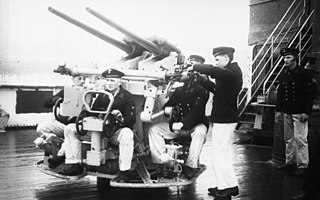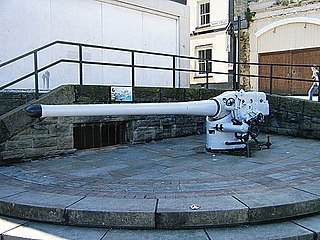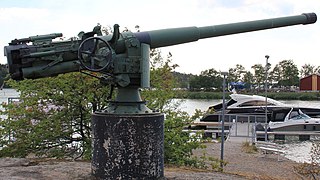
The Ordnance QF Hotchkiss 6 pounder gun Mk I and Mk II or QF 6 pounder 8 cwt were a family of long-lived light 57 mm naval guns introduced in 1885 to defend against new, small and fast vessels such as torpedo boats and later submarines. Many variants were produced, often under license, which ranged in length from 40 to 58 calibers, with 40 caliber the most common.

The QF 3-pounder Hotchkiss or in French use Canon Hotchkiss à tir rapide de 47 mm were a family of long-lived light 47 mm naval guns introduced in 1886 to defend against new, small and fast vessels such as torpedo boats and later submarines. There were many variants produced, often under license, which ranged in length from 32 to 50 calibers but 40 caliber was the most common version. They were widely used by the navies of a number of nations and often used by both sides in a conflict. They were also used ashore as coastal defense guns and later as an anti-aircraft gun, whether on improvised or specialized HA/LA mounts.

The 3.7 cm SK C/30 was the German Kriegsmarine's primary 3.7 cm (1.5 in) anti-aircraft gun during the Second World War. It was superseded by the fully automatic 3.7 cm FlaK 43 late in the war.

The 8.8 cm SK L/45 was a German naval gun that was used in World War I and World War II on a variety of mounts.

The 10.5 cm SK L/45 was a German naval gun that was used in World War I and World War II and was the successor of the older 10.5 cm SK L/40 naval gun.

The 15 cm SK L/40 was a German naval gun that was used as secondary armament on pre-dreadnought battleships, protected cruisers and armored cruisers of the Imperial German Navy in World War I. It was also used as a coast-defence gun during World Wars I and II.

The 8.8 cm SK L/30 (SK - SchnelladekanoneL - Länge was a German naval gun that was used in World War I on a variety of mounts.

The 8.8 cm SK L/35 (SK - SchnelladekanoneL - Länge was a German naval gun that was used in World War I on a variety of mounts.

The Type 41 3-inch (76 mm) naval gun otherwise known as the 8 cm/40 3rd Year Type naval gun was a Japanese dual-purpose gun introduced before World War I. Although designated as 8 cm (3.15 in), its shells were 76.2 mm (3 in) in diameter.

The 5 cm SK L/40 gun was a German naval gun used in World War I and World War II.

The 6"/40 caliber gun Mark 4 were used for the secondary batteries of the United States Navy's Indiana-class and Illinois-class battleships. They were also used as the main battery on the Cincinnati-class protected cruisers.

The 5.28 cm SK L/55 was a German naval gun that was used before and during World War I on a variety of mounts, in torpedo boats and cruisers.

The Škoda 10 cm K10 was a 100 mm (3.9-inch) naval gun of the Austro-Hungarian Navy used as tertiary armament on semi-dreadnought battleships and as primary armament on scout cruisers and destroyers during World War I. After World War I, variants of the Škoda 10 cm K10 were widely produced in Italy as the 100/47 series of guns, which served in a number of roles, on a wide variety of ships, with a number of navies.

The Cannon 76/40 Model 1916 was a widely used naval gun on ships of the Royal Italian Navy during World War I and World War II. A very versatile weapon, it was used as primary, secondary and tertiary armament on a number of ship classes, while other ship classes had a shortened version of it, the Cannon 76/30 Model 1915. After being replaced aboard ships of the Royal Italian Navy it saw widespread use on land in a number of different roles such as coastal artillery, anti-aircraft gun and railroad gun during World War II.

The 24 cm Schnelladekanone Länge 40, abbreviated as 24 cm SK L/40, was a German naval gun developed in the years before World War I that armed a number of the Imperial German Navy's pre-dreadnought battleships and armored cruisers. Later; a number of these guns were removed from naval ships and converted to coastal artillery; which would see service during World War I and World War II. The actual bore diameter was 23.8 cm (9.4 in), but the classification system for artillery rounded up to the next highest centimeter.
The Škoda 24 cm L/40 K97 was an Austro-Hungarian naval gun developed in the years before World War I that armed a class of pre-dreadnought battleships and armored cruisers of the Austro-Hungarian Navy. The actual bore diameter was 23.8 cm (9.4 in), but the classification system for artillery rounded up to the next highest centimeter.

The Canon de 37 mm Modèle 1925 was a widely used family of French anti-aircraft guns used by the French Navy during World War II.

The 102 mm 60 caliber Pattern 1911 was a Russian naval gun developed in the years before World War I that armed a variety of warships of the Imperial Russian Navy during World War I. Pattern 1911 guns found a second life on river gunboats and armored trains during the Russian Civil War and as coastal artillery during World War II. In 1941 it was estimated that 146 guns were in service. Of these, 49 were in the Baltic Fleet, 30 in the Black Sea Fleet, 30 in the Pacific Fleet, 18 in the Northern Fleet, 9 in the Caspian Flotilla and 6 in the Pinsk Flotilla.

The 120 mm 50 caliber Pattern 1905 was a Russian naval gun developed by Vickers for export in the years before World War I that armed a variety of warships of the Imperial Russian Navy. Guns salvaged from scrapped ships found a second life as coastal artillery, railway artillery and aboard river monitors during the Russian Civil War. It was estimated that there were 110 guns in the Soviet Navy's inventory in 1941. Of these, 39 were in the Baltic Fleet, 20 in the Black sea Fleet, 24 in the Amur Flotilla, 11 in the Pacific Fleet and 6 in the Pinsk flotilla in World War II.
The 15 cm/45 41st Year Type was a British naval gun designed by the Elswick Ordnance Company for export in the years before World War I that armed warships of the Imperial Japanese Navy. These guns served aboard Japanese ships during World War I and as coastal artillery during World War II.


















